Think about the last time you needed help online and got an immediate response—chances are, it was an AI chatbot.
AI chatbots in customer experience are changing the way businesses engage with customers, offering fast and accurate support round the clock. By automating common inquiries, they free up human agents for more complex issues, ensuring seamless service.
In this blog, we’ll cover the benefits of chatbots, their potential for the future, and real-world examples of how they’ve improved customer satisfaction and efficiency.
Why Should Businesses Use AI Chatbots for Enhanced CX?
Chatbots for customer service are reshaping how businesses engage with customers, offering both efficiency and convenience. Here’s why businesses should use AI chatbots for enhanced customer experience.
1. 24/7Assistance
AI chatbots provide immediate, round-the-clock responses to customer inquiries. This ensures that support is always available, even outside business hours or on holidays. Customers don’t have to wait for assistance, which results in a seamless and stress-free experience.
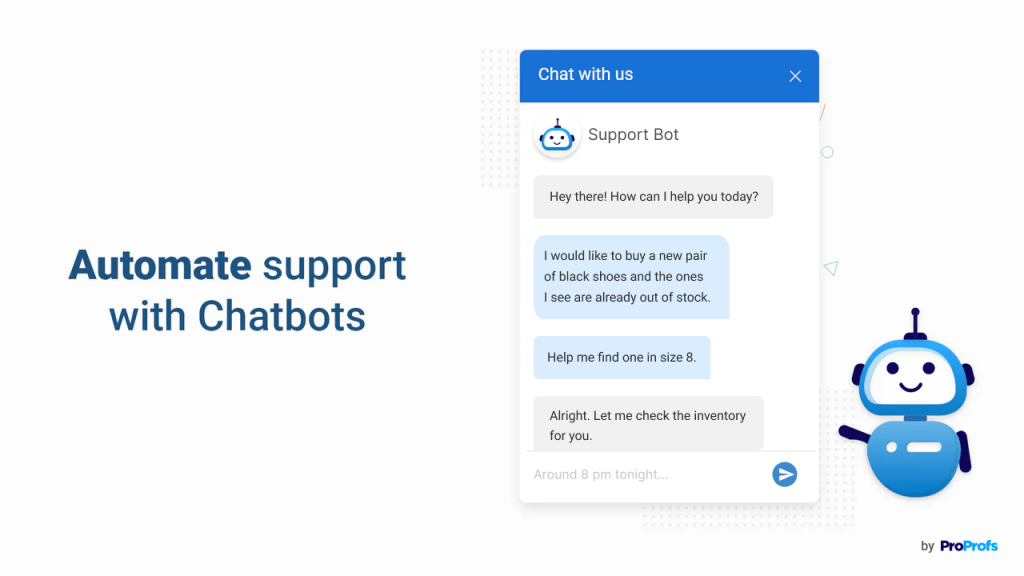
Instant responses contribute to higher satisfaction levels, as customers can get the help they need at any time of day or night.
2. Personalized Interactions
AI chatbots can analyze customer behavior, and preferences to offer tailored and personalized responses. By using this data, chatbots can deliver a more relevant, human-like experience, making customers feel recognized and valued.
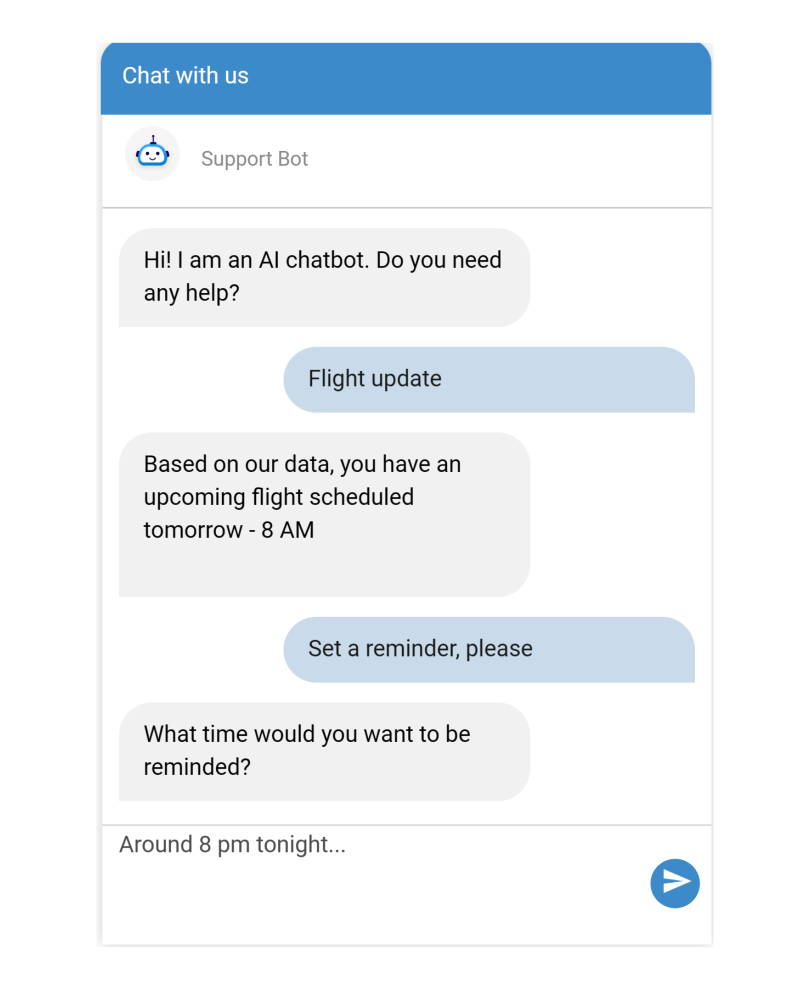
Personalized interactions lead to increased customer loyalty, as customers are more likely to return to businesses that understand and cater to their specific needs.
3. Efficiency in Handling Multiple Requests
Unlike human agents, AI chatbots can handle multiple inquiries simultaneously, ensuring that no customer is left waiting in a queue. This ability to multitask reduces bottlenecks and provides quicker resolutions for all customers.
Whether it’s addressing basic FAQs or more complex queries, chatbots improve the efficiency of your customer support team, allowing them to focus on higher-value tasks while AI handles the routine ones.
4. Cost-Effective Solution
By automating routine tasks and frequently asked questions, AI chatbots reduce the need for a large customer service team, helping businesses save money.
This cost-effective solution allows companies to allocate resources to other areas while still providing high-quality, responsive customer support.
Plus, some tools allow you to create free AI chatbots that can manage inquiries 24/7, integrate with your support system, and improve efficiency—without any upfront cost.
5. Seamless Integration with Other Channels
AI chatbots can be easily integrated with various communication platforms such as websites, mobile apps, social media, and messaging services like WhatsApp or Facebook Messenger.
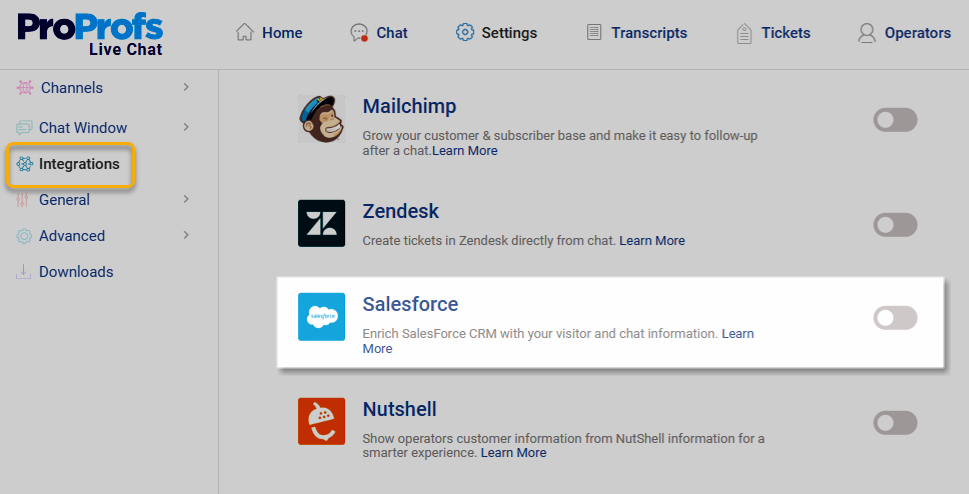
This integration ensures that customers have a consistent and unified experience across different touchpoints, regardless of how they reach out.
Whether customers choose to interact on your website or through social media, they will experience the same high-quality service.
6. Scalable Support
As businesses grow, the number of customer interactions can quickly increase. AI chatbots offer scalability that allows businesses to handle a growing volume of customer queries without needing to hire additional staff.
Whether it’s during peak seasons or normal business hours, chatbots can easily adjust to increased demand, ensuring that customers always receive prompt responses without sacrificing quality.
10 Ways to Use AI Chatbots to Improve Customer Experience
Some free AI chatbots are changing the way businesses interact with customers, making things faster and more efficient. With chatbot customer support, they help answer questions, offer support, and improve overall service. Here are 10 simple ways AI chatbots can boost customer experience:
1. Providing Instant Responses
AI chatbots are capable of providing immediate responses to customer inquiries, eliminating long wait times and making it easy for customers to get quick answers. Whether it’s about product availability, store hours, or basic service information, the chatbot ensures that no customer is left waiting.
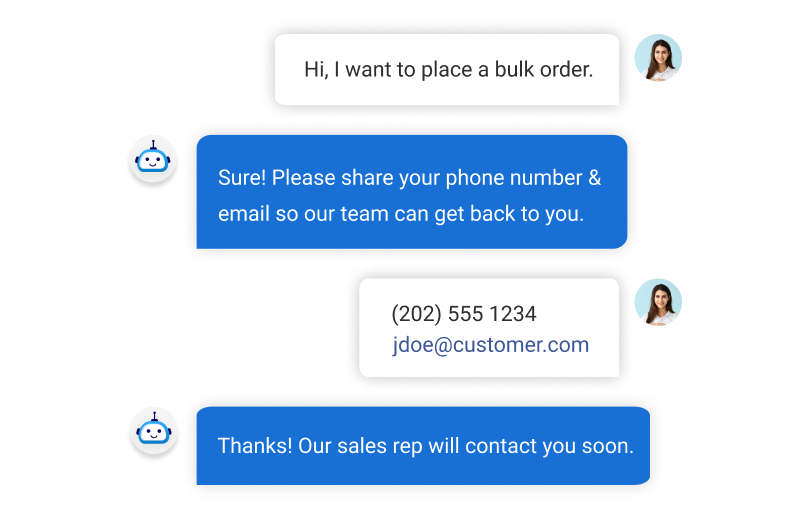
This real-time support builds trust and increases overall satisfaction, helping businesses maintain a reputation for responsiveness and reliability.
2. Answering Frequently Asked Questions (FAQs)
One of the most powerful ways AI chatbots improve customer experience is by answering frequently asked questions (FAQs). By training with your knowledge base, FAQ chatbot can instantly provide answers to questions about product features, return policies, delivery times, and more.

This automation saves both customers and support teams valuable time by eliminating repetitive questions and ensuring customers always get accurate and consistent information.
3. 24/7 Support Availability
AI chatbots never sleep! They provide round-the-clock support, ensuring that customers can get help at any time of day or night. This is especially useful for businesses with international customers in different time zones, as chatbots allow for immediate assistance without requiring human agents to be online 24/7.
Offering 24/7 support significantly boosts customer satisfaction and loyalty, as customers appreciate knowing they can always reach out when needed.
4. Streamlining Customer Onboarding
AI chatbots are excellent at at customer onboarding, guiding new customers through the setup process. Whether it’s helping them set up accounts, walk them through product features, or direct them to important resources, the chatbot ensures the customer has a smooth and seamless experience from the start.
This type of automated assistance helps customers feel confident and supported, reducing frustration and enhancing their first impression of the brand.
5. Multilingual Support
With the ability to converse in multiple languages, AI chatbots can support a global customer base. Businesses can cater to customers from different regions by offering multilingual chatbots, ensuring more convenient and user-friendly interactions.
By providing seamless communication in the customer’s native language, businesses can break down language barriers, enhance customer satisfaction, and improve the likelihood of conversions and long-term relationships.
6. Proactive Customer Engagement
AI chatbots are not only reactive—they can be proactive too! By monitoring user behavior on a website or in an app, chatbots can initiate conversations and offer assistance at just the right moment.
For example, if a customer spends a lot of time browsing a product page, the chatbot might pop up to offer more information, suggest related items, or provide a special discount.
This proactive engagement helps businesses maintain customer interest, reduce cart abandonment, and improve conversions.
7. Escalating Complex Queries
While AI chatbots excel at answering basic queries, they also know when to hand over a conversation to a human agent. When a customer presents a more complex issue, the chatbot can seamlessly escalate the query to a human support representative, ensuring that the customer’s concerns are addressed quickly and accurately.
This escalation process guarantees that customers feel supported and ensures that they never experience frustration due to the chatbot’s limitations.
8. Personalized Recommendations
AI chatbots have the ability to analyze customer data and browsing history to offer personalized product or service recommendations. By understanding past purchases, preferences, and browsing behavior, chatbots can suggest items that are more relevant to each individual customer.
This level of personalization not only increases the chances of a sale but also helps customers feel valued and understood, ultimately building stronger connections with the brand.
9. Collecting Feedback and Reviews
After a purchase or customer interaction, AI chatbots can automatically reach out to customers and request feedback or reviews. This process makes it easy for businesses to gather valuable insights into their customers’ experiences, satisfaction levels, and potential areas for improvement.
By automating this task, businesses can collect more feedback, spot trends, and continually improve their products or services while maintaining a strong relationship with their customers.
10. Processing Returns and Refunds
Returns and refunds can be a frustrating part of customer service, but AI chatbots streamline this process by guiding customers through the necessary steps. From providing return instructions to processing refund requests, the chatbot ensures that customers know exactly what to do, while also providing quick resolutions.
This automated assistance reduces customer frustration, saves time for your support team, and ensures that the return process is efficient and hassle-free for both parties.
What is the Future of AI Chatbots in Customer Service?
The future of AI customer service chatbots is promising, with advancements in technology paving the way for smarter, more intuitive, and personalized interactions. Here’s what to expect:
1. Advanced Natural Language Processing (NLP)
As AI chatbots evolve, their ability to understand and process natural language will continue to improve. They will better interpret complex sentences, slang, idioms, and even context-specific nuances, leading to conversations that feel more authentic and fluid.
This enhancement will allow chatbots to handle more sophisticated and diverse queries, offering customers an experience closer to conversing with a human agent.
2. Enhanced Personalization
AI chatbots with a well-defined chatbot persona will become much more personalized, using customer data such as previous interactions, purchase history, and behavioral patterns to tailor responses specifically to each individual.
As a result, the chatbot will not only provide relevant answers but also suggest products or services aligned with the customer’s preferences, making interactions feel unique and valued.
3. Multi-Channel Capabilities
Future AI chatbots will be seamlessly integrated into multiple channels, providing consistent support across various platforms. Whether a customer is interacting via a website, mobile app, social media, or voice assistants like Amazon Alexa or Google Assistant, the chatbot will provide the same high-quality experience.
This multi-channel adaptability will help businesses maintain a continuous and cohesive presence across all customer touchpoints.
4. Greater Use of Voice Technology
With voice recognition technology advancing, AI chatbots will increasingly incorporate voice as a primary method of interaction. This will enable hands-free communication, offering convenience to customers when they are on the go, whether they’re using smartphones, smart speakers, or other voice-enabled devices.
Voice-powered AI will further streamline the customer experience by reducing the time it takes to communicate and increasing accessibility.
5. Improved Emotional Intelligence
AI chatbots of the future will be better at detecting and understanding human emotions through sentiment analysis and contextual cues. They will recognize when a customer is frustrated, happy, or confused, and respond empathetically, adjusting their tone and approach accordingly.
This emotional intelligence will enhance customer satisfaction and create more genuine interactions, making the chatbot seem more intuitive and human-like.
6. Better Security and Privacy
As AI chatbots handle an increasing volume of sensitive data, future versions will focus heavily on securing customer interactions. With advanced encryption techniques, compliance with global privacy standards, and secure data storage practices, AI chatbots will be able to handle personal information with greater protection.
This will build trust with customers, ensuring their information remains safe and that businesses remain compliant with evolving regulations.
7. Smarter Automation and Integration
Future AI chatbots will be capable of more intelligent automation, integrating deeply with business systems like CRM, inventory management, and marketing platforms. For example, appointment scheduling chatbots can automate routine tasks like scheduling appointments, and answering common inquiries, allowing human agents to focus on more complex issues.
This seamless integration will streamline business operations, improving efficiency while maintaining a high standard of customer service.
3 Real-Life Examples of AI Chatbots
Here are three real-life examples showcasing how businesses are leveraging AI chatbots to enhance their customer service experience.
1. H&M Chatbot
H&M uses an AI chatbot, to enhance customer service by helping shoppers find products, check availability, and track orders. The chatbot assists in over 20 languages, providing a seamless shopping experience. It can also suggest outfits based on customer preferences, making the shopping journey more personalized.

Image Source: ChatbotGuide.org
The chatbot can guide users through the store and even suggest sales and promotions, creating a more engaging shopping experience.
2. Bank of America (Erica)
Erica, the AI chatbot from Bank of America, helps customers manage their finances by providing balance updates, transaction alerts, and budgeting tips. Erica’s personalized recommendations make banking more convenient.
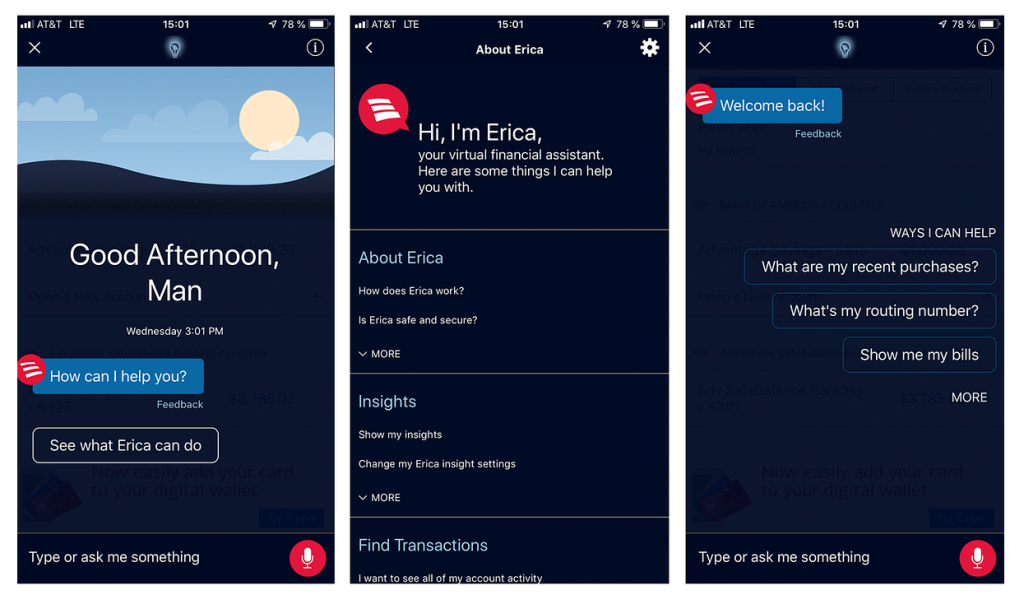
The chatbot can also analyze spending patterns and offer insights on how to save or invest smarter. With voice recognition capabilities, Erica is designed to be easily accessible, helping customers with both simple and complex banking queries.
3. Domino’s Pizza Bot
Domino’s uses its AI chatbot, Domino’s Pizza Bot, to allow customers to place orders, track deliveries, and customize pizzas through a simple chat interface. It has made ordering pizza more convenient and efficient for customers worldwide.
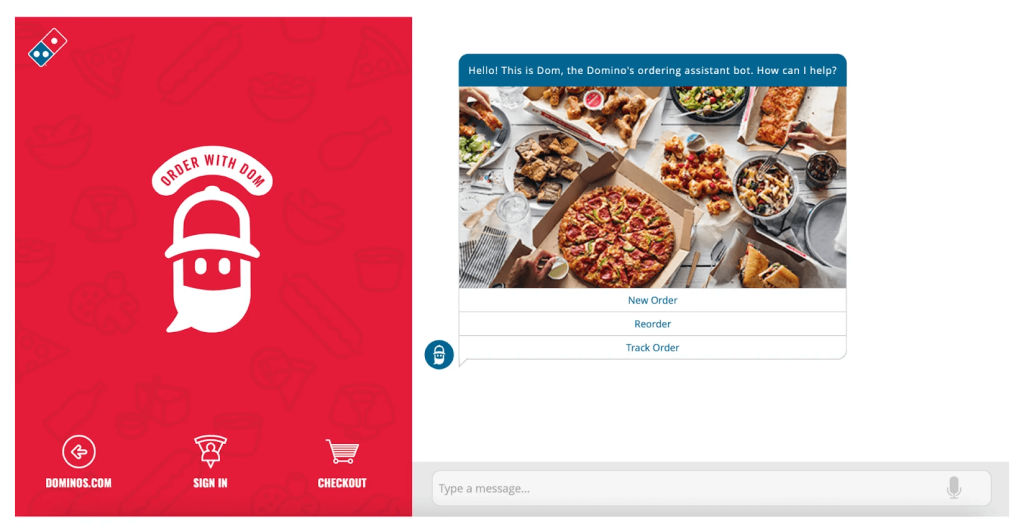
The bot remembers customer preferences and provides a quick, personalized reordering experience. It can also handle orders through various platforms, including social media and voice assistants, making it accessible across multiple touchpoints.
Enhance Support & Boost Conversions With the Best AI Chatbot
AI chatbots in customer experience are no longer a futuristic concept—they’re a practical solution reshaping how businesses interact with customers.
To make the most of AI in customer service, businesses should focus on seamless integration, continuous training, and ensuring a balance between automation and human support.
If you’re looking to upgrade your customer service strategy, consider trying ProProfs Chatbot.
With features like canned responses, real-time language translation, and chatbot analytics, ProProfs Chatbot ensures your business stays ahead in delivering delightful customer service.
FREE. All Features. FOREVER!
Try our Forever FREE account with all premium features!



